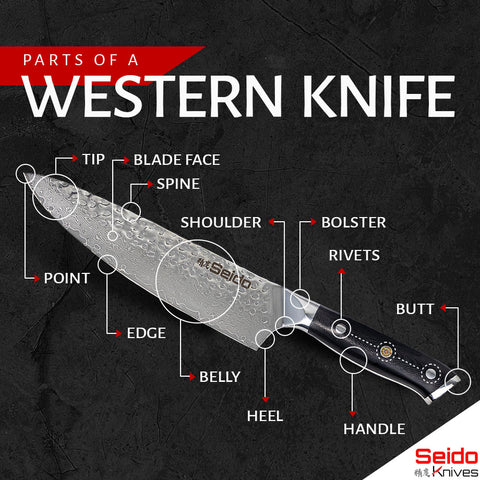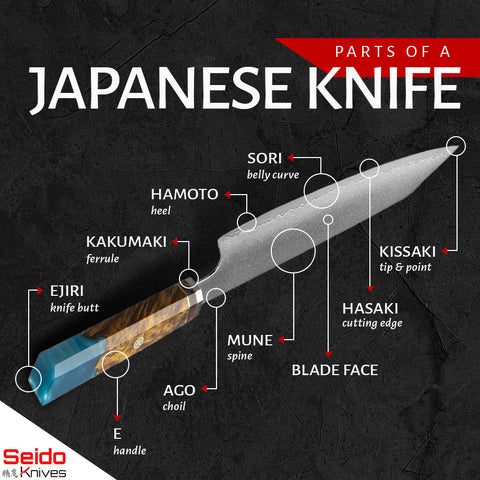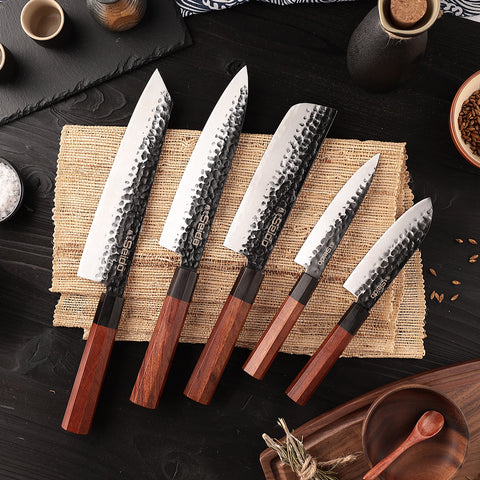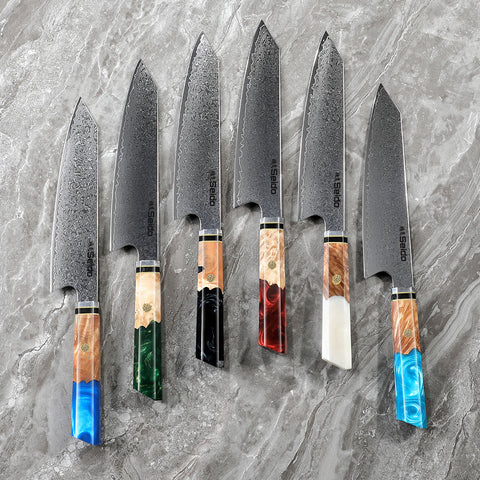Learning the various parts of a knife helps you understand how knives work. That knowledge should help you in your kitchen as you prepare food for yourself, your family, and your friends. You can get Western or Japanese knives for food prep. Exploring the anatomy of each will help you decide which style is right for your cooking.
Table of Contents
ANATOMY OF A CHEF'S KNIFE

Whether you're looking for Damascus Steel Knives, it helps to know the anatomy of a knife. Western-style chef's knives have their blades sharpened symmetrically. Doing this on both sides makes them naturally double-edged and ambidextrous for all users. Another commonality is that the handles are usually two pieces of composite or wood material that sandwich the tang before being secured with knife handle rivets.
PARTS OF A KNIFE
While a chef's knife has many aspects, it has two main parts. One is the blade, and the other is the handle.
PARTS OF A KNIFE BLADE
The many aspects of knife blade construction have specific purposes in the broader design. Some of these differ from what you would find when exploring Seido Japanese knife sets. So, you should know the parts of both before deciding between the two. The following are the parts of Western knife blades.
BLADE TIP/POINT
The specific definition of the tip of a knife blade varies, but it's often the first third of the actual blade. A sharp angle is the defining feature of this part of most chef's knives, and the primary function is piercing meat. This might be most important on a boning knife since it must pierce fish flesh before dissecting the meat horizontally. The actual knife point is where the edge and spine meet up. In addition to piercing ingredients, the tip and point are useful in delicate slicing and cuts.
BLADE FACE
The blade part of the knife is the full body past the handle. Blade sizes vary quite a bit, and you should choose one that matches the ingredients you need to cut. The edge of the blade also varies based on your intended cutting ingredient. Most knives are straight with their edge, but knives for cutting bread or slicing tomatoes might have serrations. The wide portion of a blade on either side of your knife is useful in smashing or crushing various ingredients; examples include garlic cloves, seeds, spices, and softer unshelled nuts. You might also use the face to gather food items on your cutting board to move them where you want them.
EDGE
All blade knife types have an edge. This is also known as the belly, and it's that sharp part of the blade running from the heel to the tip of the knife. This part does the cutting, and you use it for chopping, dicing, mincing, slicing, and every other cutting job. Keep your cutting easier by maintaining a sharp edge.
BELLY
If any part of a knife is to be considered the workhorse, it would be the belly. This is also the part that gets rocked the most on curved blades, which are more common on Western blades than their Japanese equivalents. The belly is usually the middle section of the blade following the tip. Since it's used for chopping, you need to make sure it's sharpened regularly.
SPINE
The knife's spine is opposite of the edge, and it's the blade's thickest part. Spine thickness varies from one knife to the next, and it determines blade stability and edge strength. Thicker spines handle more pressure than thinner ones
HEEL
The blade's heel is the opposite end of the blade from the point. It's the blade's strongest part and the edge's widest. This part is useful for cutting harder foods, such as winter squash and carrots.
PARTS OF A KNIFE HANDLE
Western knife handles typically have five parts. They are the tang, rivets, scales, bolster, and pommel.
TANG
The tang extends into the knife's handle to keep it secured. The tang should be more than half the length of the blade. If you're wondering what full tang on a knife is, it's when the tang extends to the end of the handle. This gives the knife greater strength and stability. It also makes the knife more balanced.
RIVETS
Not all knives have rivets, as some knives have molded handles. Rivets secure the tang to the knife handle, and you can sometimes see the metal rounds in the handle.
SCALES
The scales are the molded or shaped part of the knife you grip. The rivets attach the scales to the tang. Common materials include wood, steel, and plastic.
BOLSTER
The knife's bolster is the balancing point between the handle and the blade. It protects the user's fingers from the blade by providing a space of unsharpened metal between the blade and the handle. Most Western-style knives have this part, but traditional Japanese knives won't.
POMMEL
The knife pommel is also called the butt of the knife. This part helps make the knife sturdier and gives you more grip further from the blade.
Sharpen Your Culinary Expertise With the Artistry of Seido's Japanese Knives!
UNDERSTANDING THE ANATOMY OF A JAPANESE KNIFE

Japanese knife parts are different from Western knife parts. Whether you want a single Awabi Gyuto Chef Knife or a complete SEIDO™ Japanese Master Chef Knife Set, 8-Piece, you can get the most out of your traditional Japanese knives when you know their construction. Many knives have single-beveled blades angled for right- or left-hand use.
JAPANESE KNIFE PARTS
Japanese-style knives mirror Western utensils in a broad sense. They have a blade and a handle, but it's the smaller features where they differ.
PARTS OF A JAPANESE BLADE
Japanese knives are more complex. Each part gives the knife unique functionality.
HASAKI: THE CUTTING EDGE
The hasaki is the sharp edge of the blade. Its length goes from the tip to the heel.

Explore Our Finest Hasaki Japanese Chef Knife Collection →
SANTOKU: GRANTON EDGE
Granton blades feature a row of identical scallops or dimples on each side of the blade. This differs from serrated edges that are scalloped on the actual edge because Granton knives have a straight edge with scalloping on the sides. The unique nature of this edge lets users enjoy enhanced slicing and cutting because it creates tiny pockets of air between the blade and the ingredient. Improved food release minimizes tearing and shredding so that the food remains intact, and this is particularly useful with clingy or moist foods, including meats, cucumbers, cheese, and salmon.
KIREHA
Kireha translates approximately as “blade road” and is only on single-bevel knives. This part is from where the blade's beveled side starts sloping down towards the actual cutting edge.
HAGANE
Hagane is a Japanese word for hard, high-carbon steel used in the core of the blade's cutting edge. With some exceptions, the hagane gets support from an outer layer called jigane.
JIGANE
Whereas hagane is the hard steel core, jigane is the soft that covers the core. This makes it easier to sharpen the knife and lets the blade absorb shock.
CLAD LINE
A common Japanese phrase that applies here is “san-mai,” referring to the three material layers used in creating a blade. Stainless cladding involves stainless steel put into protective layers on top of the core's carbon steel.
SHINOGI
Many Japanese knives have a line separating the hira from the kireha, and this line is called the shinogi. Its practical effect is helping the blade go smoothly through any food you cut with it.
HIRA
The hira might also be called the tsura, the upper half of a blade's beveled side. Instead of being at an angle, a hira is flat. Two varied surfaces provide a visually pleasing contrast and keep food from sticking to the blade's sides.
MUNE: THE SPINE
The mune is also called the se and is equivalent to the Western spine. It doesn't serve a specific utility purpose, but it might indicate whether the knife was made by hand or machine. Knives made manually often have spines that get narrower as they approach the tip, and that is often indicative of a knife being hammered into its shape. Machine-created knives usually have a consistent thickness as they are cut from steel sheets before sharpening.
KISSAKI: BLADE TIP AND POINT
The kissaki is the blade tip for precise work, such as trimming meat fat. This part is often the most delicate component of your knife, but it's also a very essential one to have. Accidentally chipping this off happens to many knife owners, but that usually happens if the knife gets knocked to the ground. Keep your knife away from counter edges to prevent this.
SORI: THE BELLY CURVE
Sori means belly curve; not all Japanese knives have it. This is best exemplified by Japanese chef's knives. Use a knife with a sori for draw-cuts and rock-chopping.

HAMOTO: THE HEEL
Part of the knife heel is called the hamoto, which runs from the heel point to around the middle of the blade. If you need to do fine cutting and your knife tip doesn't offer enough control, this part can be a useful substitute.
AGO: THE CHOIL
Ago means “chin” and is the blade's flat piece going down to the heel point. This part might have a slight slant or form a right angle.
MACHI
The machi is a small gap between the handle and the knife neck. Not all Japanese knives have this. With this part, a professional can adjust the handle for size if the knife isn't comfortable. Gentle hammering on the handle might push it up the machi so the handle moves closer to the blade.
NAKAGO: TANG
The Japanese term for the tang of Western knives is nakago. It's hidden in Japanese knives because the lower part of the blade is attached to the handle.
JAPANESE WA HANDLES: TYPES AND SHAPES
Japanese knife hilts are characteristically wa knife handles made of a wooden holder. Wa knife handles are distinguished by a lack of bolster and rivets, typical in Western knives. Instead, Japanese knives have cylindrical shaped handles without bolsters. Some handles in this style are just pieces of wood and don't have a ferrule or collar.

Discover the Wa Handle Japanese Chef Knife →
ROUND
Round wa handles are ambidextrous and the most traditional shape in this style. However, this style is rarely used on knives exported to other countries.
OVAL
Oval handles are ambidextrous and possibly the most comfortable option in this category. An oval handle orients the knife properly in the vertical plane, giving the user effective control over the instrument.
D-SHAPED (SHINOGI)
Shinogi handles are either right- or left-handed, and the knife is oriented strongly along the vertical plane. They are known for being the most precise and give you tremendous control.
OCTAGONAL (WA)
Like the other handles on this list, a wa handle offers good vertical plane orientation for greater control. This handle style might be the most common among Japanese knives.
SHIELD (HINOURA)
This ambidextrous style works in anyone's hands, but it's especially good for people with smaller hands. It might be rounded at the bottom.
WESTERN VS. JAPANESE KNIFE HANDLES
Western knives are more likely to have riveted handles, but Japanese knives are usually just as sturdy and durable. You may find they're equally comfortable in your hands. Still, Japanese knives offer more finesse on your cutting board. The lack of riveting in Japanese knives also means that a professional can easily replace the blade if you need that done.

WHAT TO LOOK FOR
Now that you know the parts of both kinds of knives, what specific factors should guide your decision?
SHARPNESS OF THE BLADE
You need a sharp blade to make slicing, chopping, and cutting easier. Blunt knives increase the likelihood of accidents in your kitchen.
BLADE-TO-HANDLE CONNECTION
Every blade needs a strong handle connection so your knife doesn't fall apart. You don't want to cut yourself instead of the food before you.
SLOPED BOLSTER
A sloped bolster runs through the blade's bottom and should prevent blade contact when the knife is in use. This allows you a better grip and the full edge of the knife when you are chopping.
HIGH-QUALITY STEEL
A knife is only as good as the caliber of its steel, but you don't have to spend much to get a lot. Damascus steel is a good choice. Seido Knives has an extensive collection of Damascus steel knives.
But high carbon steel also works. Check out your VG-10 steel and AUS-10 steel options.
MAKE A SHARP CHOICE
Two things should determine whether or not you get Western or Japanese knives. First, consider the cooking you do. Second, decide how precise you want your cuts. Western knives are fine for chopping celery, garlic, and carrots, but Japanese knives typically do better when trimming tenderloin, slicing fish, or cutting into softer vegetables. Nothing stops you from getting both styles, but Japanese-style knives usually offer more control and stability for sharper cuts.
Explore Our Premium Western & Japanese Knives Here →



